You don’t need a complicated smart home to fix one inconvenient light switch. Here’s how a no hub smart switch offers a simple, direct solution.
We’ve all got one. The Phantom Switch. The one in the kitchen that’s inconveniently stuck behind the microwave. The one at the top of the basement stairs that’s only reachable after you’ve already stumbled down in the dark. It’s a small, daily annoyance that feels like it should have a simple fix. And thankfully, it does. You can solve this problem with a no hub smart switch, and the best part is, you don’t need to turn your home into a complex, voice-activated command center to do it.
You just want a switch that works, but in a better spot. No apps, no voice commands, no extra gadgets cluttering your Wi-Fi network. You want the instant, reliable response of a standard “dumb” switch, just… relocated. I get it completely. The world of smart homes can feel overwhelming, but this specific problem has a wonderfully simple and direct solution.
Why a No Hub Smart Switch is Your Best Bet
Before we dive into the options, let’s quickly talk about what a “hub” even is. In many smart home setups, a hub (or bridge) acts as a central translator. It speaks to all your different smart devices (lights, plugs, sensors) and connects them to your home network. It’s powerful if you’re building a fully integrated system.
But what if you’re not?
For a simple task like relocating a switch, a hub is often overkill. It adds another layer of complexity, another device to plug in, and another potential point of failure. Choosing a no hub smart switch setup offers a few key advantages:
- Simplicity: You’re dealing with fewer components. It’s a more direct line from the remote to the switch itself.
- Lower Cost: No need to buy an extra piece of hardware.
- Direct Control: Many hub-less options communicate directly, avoiding potential Wi-Fi lag for a faster, more reliable connection.
Your Options for a Simple, Hub-less Solution
When you strip away all the fancy features, you’re left with two main paths to get that direct, responsive control you’re looking for.
1. RF (Radio Frequency) Switch Kits
This is likely the purest solution for what you want. An RF switch kit is beautifully straightforward. It typically comes with two parts:
- The Receiver: This is the part that gets wired into your wall, replacing your existing “dumb” switch.
- The Remote: This is a wireless, battery-powered switch that you can mount literally anywhere you want with adhesive tape or screws.
They talk to each other directly using a radio frequency, much like a garage door opener. There’s no Wi-Fi, no app, and no hub involved. When you press the remote, it sends a direct signal to the receiver. It’s fast, reliable, and incredibly simple to set up. It’s the closest you’ll get to the feel of a traditional wired switch. There are many great options available online that are specifically designed for this purpose.
2. Wi-Fi Enabled Smart Switches
Now, I know the goal is to avoid Wi-Fi routing, but it’s worth mentioning the most common type of no hub smart switch: the Wi-Fi switch. Brands like Leviton or TP-Link Kasa make switches that connect directly to your home’s Wi-Fi network.
While these do use Wi-Fi, they don’t require a separate hub. The switch itself is the only “smart” component you need. You can then pair it with a wireless remote (often sold separately) or control it from your phone. For the simple goal of relocating a switch, the RF option is often more direct. However, if you think you might want the option to control the light with your phone occasionally, this is a great, simple entry point without committing to a full smart home ecosystem. For a deep dive into the different technologies, check out this great explainer on how smart devices communicate.
A Few Things to Check Before You Buy
Before you add anything to your cart, here are a couple of practical things to keep in mind:
- Check for a Neutral Wire: Many smart switches require a neutral wire to power themselves. Older homes sometimes don’t have one in the switch box. It’s a good idea to safely turn off the power and check what’s behind your current switch plate first. There are plenty of guides online to help you identify a neutral wire.
- Voltage and Regional Standards: As the original inspiration for this post came from someone in Armenia, it’s a critical reminder: electricity isn’t the same everywhere. Always confirm that the switch you’re buying is compatible with your region’s voltage (e.g., 120V in North America, 230V in Europe) and socket standards.
- The Remote’s Form Factor: Think about where you’ll put the new remote. Do you want one that looks just like a regular wall switch? Or would a smaller, more discreet “pico” style remote be better?
Ultimately, fixing that one annoying light switch doesn’t have to be a gateway to a smart home you don’t want. A simple, direct solution is out there, and it’s probably easier to install than you think. You can get the convenience you need without any of the extra baggage.
